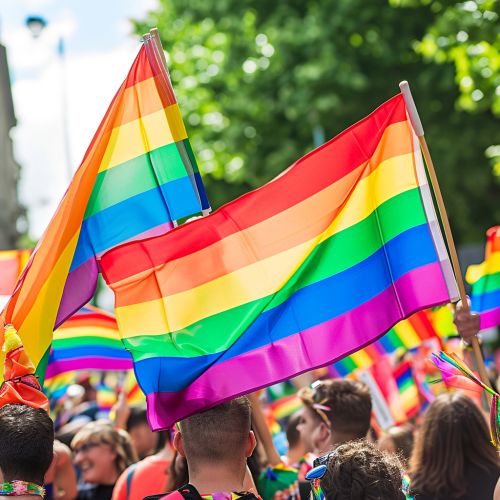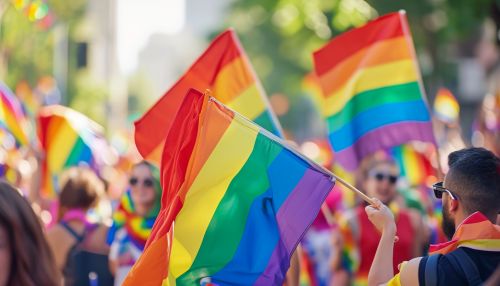LGBTQ+ culture
Overview
The LGBTQ+ culture refers to the shared cultural experiences, practices, and beliefs of individuals who identify as lesbian, gay, bisexual, transgender, and queer or questioning, as well as other sexual orientations and gender identities. This culture is characterized by a rich history, diverse expressions of identity, and a strong sense of community. It is also marked by a history of struggle for recognition, acceptance, and equality.
History
The history of LGBTQ+ culture is a complex tapestry of experiences, struggles, and victories. It is marked by periods of repression and persecution, as well as periods of acceptance and celebration. The history of LGBTQ+ culture is also intertwined with the broader social and political history of the societies in which it exists.
Early History
The presence of individuals who would today be identified as part of the LGBTQ+ community can be traced back to ancient civilizations. In many cultures, such as Ancient Greece and Rome, same-sex relationships and gender variance were accepted and often celebrated. However, with the rise of Christianity and other monotheistic religions, attitudes towards homosexuality and gender variance shifted, leading to centuries of persecution and marginalization.
Modern History
The modern history of LGBTQ+ culture begins in the late 19th and early 20th centuries, with the emergence of the first gay rights organizations in Europe. The 20th century saw significant advances in the recognition and acceptance of LGBTQ+ individuals, particularly in Western societies. This period also saw the emergence of the modern LGBTQ+ rights movement, which has fought for the recognition and protection of LGBTQ+ rights.
Identity and Expression
Identity and expression are central aspects of LGBTQ+ culture. This includes sexual orientation, gender identity, and gender expression. The LGBTQ+ community is incredibly diverse, encompassing a wide range of identities and expressions.
Sexual Orientation
Sexual orientation refers to an individual's enduring pattern of emotional, romantic, and/or sexual attractions to men, women, both genders, or neither gender. It also refers to an individual's sense of personal and social identity based on those attractions. In the LGBTQ+ community, there are many different sexual orientations, including but not limited to lesbian, gay, bisexual, and queer.
Gender Identity
Gender identity refers to an individual's internal sense of their own gender. This may be male, female, a blend of both, or neither. Transgender individuals, for example, have a gender identity that does not align with their assigned sex at birth. Non-binary individuals do not identify exclusively as male or female.
Gender Expression
Gender expression refers to the ways in which individuals express their gender identity. This can include behavior, clothing, hairstyles, voice, body characteristics, and more. In LGBTQ+ culture, there is a wide range of gender expressions, from traditionally masculine and feminine expressions to androgynous or gender-neutral expressions.
Community and Activism
The LGBTQ+ community is a vital aspect of LGBTQ+ culture. This community provides support, acceptance, and a sense of belonging for individuals who may face discrimination or misunderstanding in other areas of their lives. The LGBTQ+ community is also a powerful force for activism, fighting for the rights and acceptance of LGBTQ+ individuals.


Community
The LGBTQ+ community is incredibly diverse, encompassing individuals of all ages, races, ethnicities, religions, and socioeconomic statuses. This community provides a space for individuals to express their identities, share their experiences, and find acceptance. Community spaces can include LGBTQ+ organizations, clubs, events, online spaces, and more.
Activism
Activism is a central aspect of LGBTQ+ culture. The LGBTQ+ rights movement has fought for the recognition and protection of LGBTQ+ rights, including the right to marry, the right to serve in the military, and protection from discrimination. Activism also includes efforts to increase visibility and understanding of LGBTQ+ individuals and issues.
Representation
Representation of LGBTQ+ individuals in media and popular culture is an important aspect of LGBTQ+ culture. This includes representation in film, television, music, literature, and more. Representation can help to increase visibility and understanding of LGBTQ+ individuals and issues, as well as provide role models for LGBTQ+ individuals.
